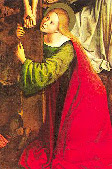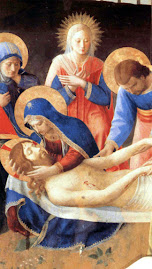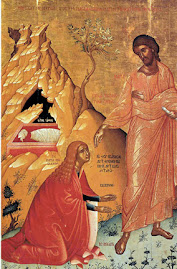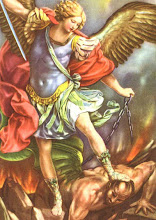
JESUS ETERNAL VIRGIN
Analysis of Martino Gerber and Guliano Lattes, biblical scholars
**********************************************************
In recent times many write books and novels which insist that Jesus was married or that He could do.
The Holy Bible, however, teaches that Jesus is the Eternal Virgin.
********************************
In the Gospel, Jesus teaches us that in the resurrected life the elected saints will live in the Kingdom of God,
and they will live like angels and do not take a wife or husband;
Luke 20: 34-37
34 Jesus replied, 'The children of this world take wives and husbands,
35 but those who are judged worthy of a place in the other world and in the resurrection from the dead do not marry
36 because they can no longer die, for they are the same as the angels, and being childenof the resurrection they are children of God.
37 And Moses himself implies that the dead rise again, in the passage about the bush where he calls the Lord the God of Abraham, the Godof Isaac and the God of Jacob
Now we see that both the angels and the elected saints resurrected, are children of God, they can not take a wife or husband, they can not have sex, but they live most chaste and pure.
**************************
Jesus before being born into this world, lived with God was the Word and the Son of God;
John 1: 1
1 In the beginning was the Word: the Word was with God and the Word was God.
John 1: 14
14 The Word became flesh, he lived among us, and we saw his glory, the glory that he has from the Father as only Son of the Father, full of grace and truth.
So Jesus existed before being born into this world, and He taught this;
John 3: 13
13 No one has gone up to heaven except the one who came down from heaven, the Son of man;
John 6: 51
51 I am the living bread which has come down from heaven. Anyone who eats this bread will live for ever;
and the bread that I shall give is my flesh, for the life of the world.'
Jesus explains His eternal existence very clearly;
John 8: 58
58 Jesus replied: In all truth I tell you, before Abraham ever was, I am.
John 17: 5
5 Now, Father, glorify me with that gloryI had with you before ever the world existed.
John 17: 24
24 Father, I want those you have given me to be with me where I am, so that they may always see my glory which you have given me because you loved me before the foundation of the world.
So Jesus is God, and being in the world He can not get married, but He was like an angel.
**********************************************************************
We see that Jesus was not born from a marriage union, but through the Holy Spirit;
Matthew 1: 20-21
20 He had made up his mind to do this when suddenly the angel of the Lord appeared to him in a dream and said,
'Joseph son of David, do not be afraid to take Mary home as your wife, because she has conceived what is in her by the Holy Spirit.
21 She will give birth to a son and you must name him Jesus, because he is the one who is to save his people from their sins.'
Luke 1: 26-35
26 In the sixth month the angel Gabriel was sent by God to a town in Galilee called Nazareth,
27 to a virgin betrothed to a man named Joseph, of the House of David; and the virgin's name was Mary.
28 He went in and said to her, 'Rejoice, you who enjoy God's favour! The Lord is with you.'
29 She was deeply disturbed by these words and asked herself what this greeting could mean,
30 but the angel said to her, 'Mary, do not be afraid; you have won God's favour.
31 Look! You are to conceive in your womb and bear a son, and you must name him Jesus.
32 He willbe great and will be called Son of the Most High. The Lord God will give him the throne of his ancestor David;
33 he will rule over the House of Jacob for ever and his reign will have no end.'
34 Mary said to the angel, 'But how can this come about, since I have no Knowledge of man?'
35 The angel answered, 'The Holy Spirit will come upon you, and the power of the Most High will cover you with its shadow.
And so the child will be holy and will be called Son of God.
Jesus was born as God incarnate, He can not marry, even if He takes human nature, He retains His divine nature.
****************************************************************************************
John the Baptist called Jesus the Lamb of God, to show His purity and holiness;
John 1: 35-36
35 The next day as John stood there again with two of his disciples, Jesus went past,
36 and John looked towards him and said, 'Look, there is the lamb of God.'
************************************************************************
Jesus makes His divine nature to be known by His Apostles, before the resurrection, in the transfiguration;
Matthew 17: 1-5
1 Six days later, Jesus took with him Peter and James and his brother John and led them up a high mountain by themselves.
2 There in their presence he was transfigured: his face shone like the sun and his clothes became as dazzling as light.
3 And suddenly Moses and Elijah appeared to them; they were talking with him.
4 Then Peter spoke to Jesus. 'Lord,' he said, 'it is wonderful for us to be here; if you want me to, I will make three shelters here, one for you, one for Moses and one for Elijah.'
5 He was still speaking when suddenly a bright cloud covered them with shadow, and suddenly from the cloud there came a voice which said, 'This is my Son, the Beloved; he enjoys my favour. Listen to him.'
******************************************************************
Jesus appeared as the third person of the Holy Trinity, He is the Son of God, God is his Father, and with them is the Holy Spirit;
Matthew 3: 16-17
16 And when Jesus had been baptised He at once came up from the water, and suddenly the heavens opened and he saw the Spiritof God descending like a dove and coming down on him.
17 And suddenly there was a voice from heaven, 'This is my Son, the Beloved; my favour rests on him.'
Matthew 28: 18-20
18 Jesus came up and spoke to them. He said, 'All authority in heaven and on earth has been given to me.
19 Go, therefore, make disciples of all nations; baptise them in the name of the Father and of the Son and of the Holy Spirit,
20 and teach them to observe all the commands I gave you. And look, I am with you always; yes, to the end of time.'
So Jesus being the third person of the Holy Trinity, He can not get married.
***********************************************************************
Jesus reveals His divine qualities, He teaches that He is the Bread that came down from heaven;
John 6: 51
51 I am the living bread which has come down from heaven.
Anyone who eats this bread will live for ever; and the bread that I shall give is my flesh, for the l life of the world.'
Jesus explains this well at the Last Supper;
Matthew 26: 26-28
26 Now as they were eating, Jesus took bread, and when he had said the blessing he broke it and gave it to the disciples. 'Take it and eat,' he said, 'this is my body.'
27 Then he took a cup, and when he had given thanks he handed it to them saying, 'Drink from this, all of you,
28 for this is my blood, the blood of the covenant, poured out for many for the forgiveness of sins.
Now Jesus the Bread of heaven can not get married.
********************************************************
Jesus teaches that He is the Light;
John 8: 12
12 When Jesusspoke to the people again, he said: I am the light of the world; anyone who follows me will not be walking in the dark, but will have the light of life.
Now Jesus the divine Light can not get married.
************************************************************
Jesus claims to be the Son of God;
John 10: 30
30 The Father and I are one.
Jesus the Son of God can not take a wife.
**********************************************
Jesus declares that He is the Resurrection;
John 11:25
25 Jesus said: I am the resurrection. Anyone who believes in me, even though that person dies, will live.
Jesus is the divine resurrection and the eternal life, He can not get married.
***************************************************
Jesus claims to be the Way, Truth and Life:
John 14: 6
6 Jesus said: I am the Way; I am Truth and Life. No one can come to the Father except through me.
Jesus is the divine Way, Truth and Life, He can not get married.
************************************************************
Jesus reveals that who sees Him sees the Father;
John 14: 7-11
7 If you know me, you willknow my Father too. From this moment you know him and have seen him.
8 Philip said, 'Lord, show us the Father and then we shall be satisfied.' Jesussaid to him,
9 'Have I been with you all this time, Philip, and you still do not know me? 'Anyone who has seen me has seen the Father, so how can you say, "Show us the Father"?
10 Do you not believe that I am in the Father and the Father is in me? What I say to you I do not speak of my own accord: it is the Father, living in me, who is doing his works.
11 You must believe me when I say that I am in the Father and the Father is in me; or at least believe it on the evidence of these works.
Jesus is God and He can not get married.
******************************************************************
Then Jesus lived virgin and He is virgin forever. Jesus also advised his followers to remain virgin for the kingdom of heaven;
Matthew 19: 12
12 There are eunuchs born so from their mother's womb,
there are eunuchs made so by human agency and there are eunuchs who have made themselves so for the sake of the kingdom of Heaven.
Let anyone accept this who can.'
Now if Jesus asks to His followers to remain virgin, He virgin certainly.
********************************************************************
Even St. Paul advises believers to virginity;
1 Corinthians 7: 7-8
7 I should still like everyone to be as I am myself; but everyone has his own gift from God, one this kind and the next something different.
8 To the unmarried and to widows I say: it is good for them to stay as they are, like me.
1 Corinthias 7: 32-34
32 I should like you to have your minds free from all worry. The unmarried man gives his mind to the Lord's affairs and to how he can please the Lord;
33 but the man who is married gives his mind to the affairs of this world and to how he can please his wife, and he is divided in mind.
34 So, too, the unmarried woman, and the virgin, gives her mind to the Lord's affairs and to being holy in body and spirit;
but the married woman gives her mind to the affairs of this world and to how she can please her husband.
**************************************************************************
St. Paul imitates Jesus, then he is unmarried;
1 Corinthias 11: 1
1 Take me as your pattern, just as I take Christ for mine.
*************************************************
Jesus has His bride anyway, the church;
Ephesians 5: 21-33
21 Be subject to one another out of reverence for Christ.
22 Wives should be subject to their husbands as to the Lord,
23 since, as Christ is head of the Church and saves the whole body, so is a husband the head of his wife;
24 and as the Church is subject to Christ, so should wives be to their husbands, in everything.
25 Husbands should love their wives, just as Christ loved the Church and sacrificed himself for her
26 to make her holy by washing her in cleansing water with a form of words,
27 so that when he took the Church to himself she would be glorious, with no speck or wrinkle or anything like that, but holy and faultless.
28 In the same way, husbands must love their wives as they love their own bodies; for a manto love his wife is for him to love himself.
29 A mannever hates his own body, but he feeds it and looks after it; and that is the way Christtreats the Church,
30 because we are parts of his Body.
31 This is why a manleaves his father and mother and becomes attached to his wife, and the two become one flesh.
32 This mystery has great significance, but I am applying it to Christ and the Church.
33 To sum up: you also, each one of you, must love his wife as he loves himself; and let every wife respect her husband.
*************************************************************
Conclusion: Jesus is divine and heaven nature, He was like an angel, He could not and did not want to marry.
Jesus loved the virginity and advised the virginity to those who could, for the Kingdom of Heaven.
Jesus taught us to pray that is the Rhine of Heaven soon, where all the angels and the elect saints will live holy and pure.
**************************************************************
Biblical quotations
New Jerusalem Bible
http://www.catholic.org/bible/
http://groups.google.com/group/christianbiblestudies?hl=it







